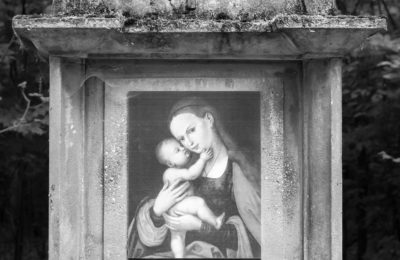This past Sunday, J. David took this picture (above) of the stained glass window of the the Nativity in St. Peter Church, Steubenville, Ohio. That window, and another fifteen (plus), that perch high on the walls of that beautiful church, were crafted in Germany over one hundred years ago. I cannot imagine the innumerable eyes that have beheld their beauty in the years since their installation. How many children have gazed at them, learning their Faith through them; having the Faith, as it were, imprinted on their hearts? In our gray-loving, modern age of monochromatic dressing and art, these colorful beauties speak to us of an earlier type of man, a man who loved color: color in dress, color in art, color in life. These men, the artists, and those who commissioned such art, must have been Men-alive.
In his day, G.K. Chesterton (b. 1874- d. 1936), lamented the fact that the art of stained glass was dying, for he loved stained-glass windows in churches, and wrote of them:
“The Christian windows are solid and human, made of heavy lead, of hearty and characteristic colours; but behind them is the light. The colours of the fireworks are as festive and as varied; but behind them is the darkness. . . .The rockets of ruby and sapphire fade away slowly upon the dome of hollowness and darkness. But the kings and saints in the old Gothic windows, dusky and opaque in this hour of midnight, still contain all their power of full flamboyance, and await the rising of the sun.”
The colors of the windows are illuminated by the sun, and the windows reach their peak beauty, and flamboyance, at the rising of the sun. It is as if the colors of the windows come alive each day, backlit by the sun, by God. Chesterton spoke of these flaming stained glass colors:
“The visible clue to the Middle Ages is colour. The mediaeval man could paint before he could draw. In the almost startling inspiration which we call stained glass, he discovered something that is almost more coloured than colour; something that bears the same relation to mere colour that golden flame does to golden sand. He did not, like other artists, try in his pictures to paint the sun; he made the sun paint his pictures. He mixed the aboriginal light with the paints upon his palette.”
In a stained glass window, the aboriginal light is mixed with the paints on the palette of the artist.
I am thankful for the Catholic artisans who created, and the men and women who commissioned, and paid for, the stained glass windows which bejewel our Catholic churches. Hopefully there will be a return to the appreciation of such artistry; a return to the love of color, and the return to a love of life and beauty.
•SCF






